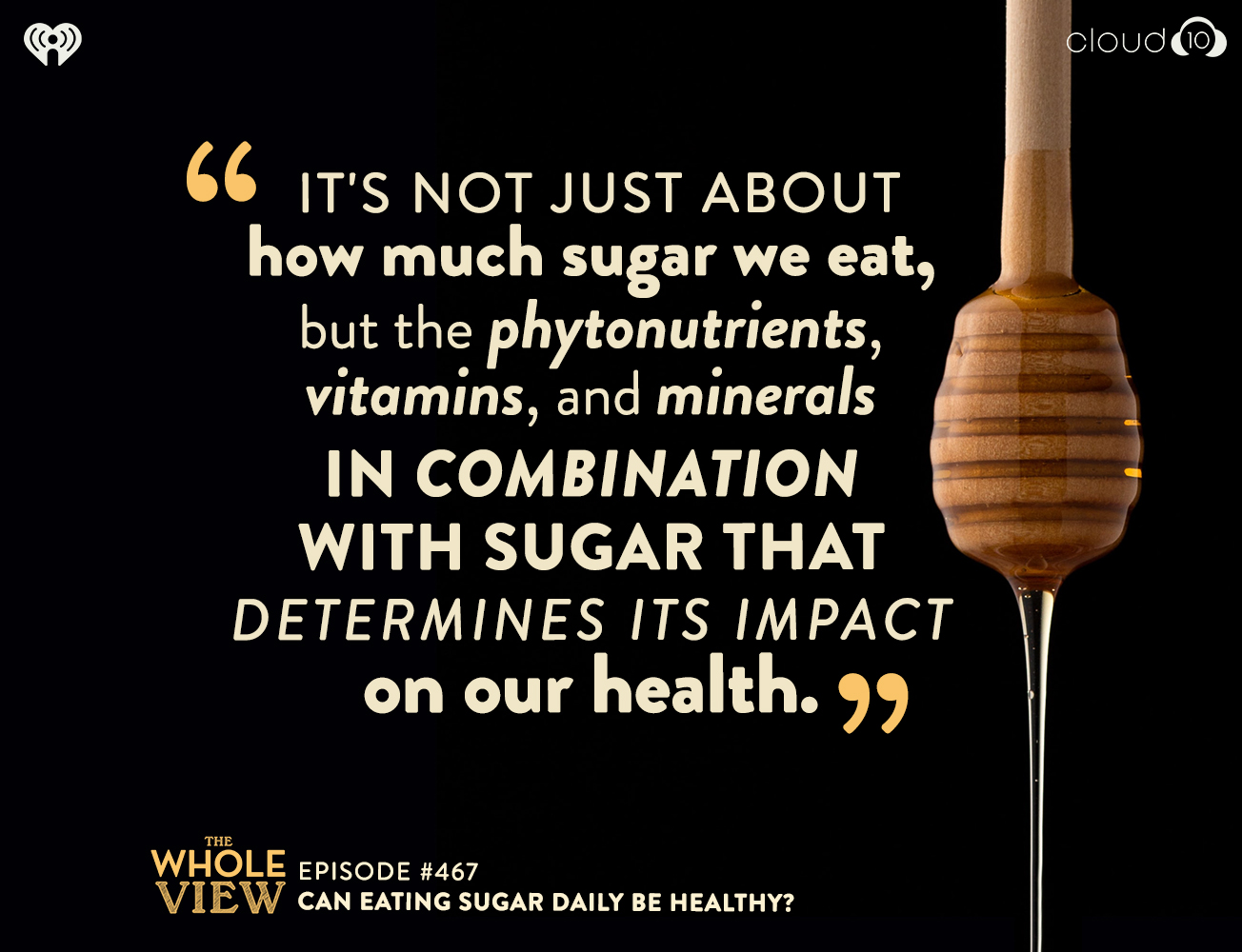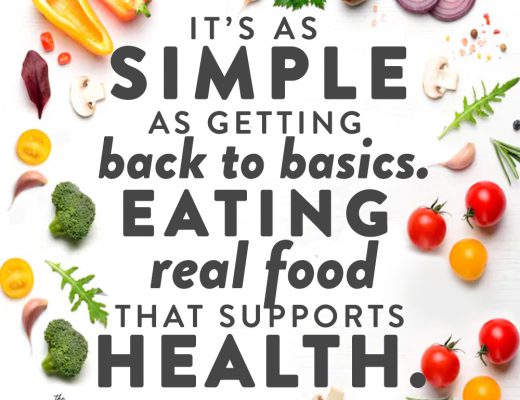
Welcome to episode 467 of The Whole View! This week, Stacy and Dr. Sarah look at the science behind sugar consumption to answer whether or not eating sugar daily can be part of a healthy diet.
If you enjoy the show, please review it on iTunes!
The Whole View, Episode 467: Can Eating Sugar Daily Be Healthy?
Welcome back to episode 467! (0:28)
This week’s listener questions comes from Grace over on Patreon:
Dear Stacy and Dr. Sarah,
I am a long time fan of your amazing podcast and both of your blogs, and took the AIP lecture series a couple years ago and learned so much. I have listened to the whole series at least three times, and your voices have become like part of my brain now 🙂 I feel so much attachment to both of you, and can’t tell you how much I appreciate the contributions you’ve made to my life.
My problem is sugar. I follow a maintenance AIP and my meals are great — ALL the veggies and seafood and healthy starchy veggies and working on organ meats! — but I have this one kind of ridiculous habit that I haven’t shaken. Namely, I have always been a sugar lunatic. In my twenties, I drank a million diet Cokes a day and ate just hordes of candy, and over the years I have tried to stop eating sugar a number of times but find it so hard.
Even during the elimination phase of AIP I struggled — I would eat power balls and have spoonfuls of honey from the jar! Now I’m eating healthier than ever and have for years, but I eat sugar almost every evening — honey in tea, dark chocolate, some paleo treats, and if my kids have candy around, I find it so hard not to eat. I know it is not rational to eat AIP except candy of all things…
Anyway, I’m hoping you might be up for a new sugar show. I feel like maybe I just need to really get why sugar is so bad. I was wondering if you could update on how does sugar affect the microbiome? Inflammation? I am hoping that maybe I can get some info that I can hang my hat on!
Love and appreciate you both so much.
Grace
Previous Episodes On Sugar
Stacy and Dr. Sarah talked about consuming real natural sugars (like organic cane sugar, honey, and maple syrup) in moderation recently on Episode 459: Gluten-Free Baking, Our Best Tips, and Tricks!
Sugar in moderation can fit into a healthy diet, but it’s important to emphasize that sugar substitutes are not a good trade.
They’ve also discussed carb intake and insulin in episodes:
- 365: Does Paleo Cause Heart Disease?
- 329: The Link Between Carb Intolerance & Gut Health
- 305: Why Insulin Is Important & Awesome!
- 437: Intro To Nutrivore
Sugar, Insulin, and Inflammation
Dr. Sarah starts with how high sugar intake can be harmful to our health. (8:15)
Sugars, also called simple carbohydrates or simple sugars, include:
- monosaccharides like glucose, fructose, and galactose, and
- disaccharides like sucrose (one fructose and one glucose),
- lactose (one glucose and one galactose) and maltose (two glucoses).
The body digests and absorbs sugars quickly. As a result, the glucose they contain has a rapid impact on blood sugar levels and insulin secretion, which shuttles glucose into our cells.
Our cells convert glucose into adenosine triphosphate (ATP), the energy currency for all cells. It’s made through a series of chemical reactions, collectively referred to as cellular respiration (since the process uses oxygen and produces carbon dioxide).
ROS & Postprandial Inflammation
ROS is a byproduct of cellular respiration and reactive oxygen species (ROS), aka oxidants or free radicals.
Reactive oxygen species (ROS) are a group of chemically reactive molecules that contain oxygen. They have important roles in cell signaling and homeostasis.
However, ROS are potent signals for inflammation and can damage cells and tissue. As a result, our immune system cells produce and secret ROS as one weapon in their arsenal to defend us from pathogens.
In general, the more energy (food) consumed, the more ROS produced.
Postprandial oxidative stress or postprandial inflammation is the production of ROS after meals, and it continues to be a topic of intense study.
In this sense, all foods are inflammatory. However, some eating patterns cause more oxidative stress and inflammation than others.
Overeating, in general, is the biggest culprit because it stimulates ROS production by flooding the body with energy. Another cause is high carbohydrate (especially refined carbohydrate) intake, even in reasonable caloric intake.
Put simply, the more glucose we eat, the more inflammation!
Insulin Sensitivity & Context
An increase in ROS production and markers of inflammation has linked the consumption of glucose even in healthy people.
However, people with obesity, type 2 diabetes, high cholesterol, or metabolic syndrome have more exaggerated production.
This is because postprandial inflammation is proportional to insulin sensitivity, or how effectively the body responds to insulin. Therefore, the less insulin-sensitive (or the more insulin-resistant) someone is, the more inflammation it creates every time.
Simple sugars and refined carbohydrates known to spike blood sugar levels cause more inflammation than whole food sources of complex carbohydrates.
It’s worth noting that insulin sensitivity is more closely related to lifestyle than diet, but that doesn’t mean diet isn’t also important!
In normal circumstances, antioxidants (certain vitamins and most phytochemicals) balance out the deleterious effects of these highly reactive molecules.
When the production of ROS exceeds the availability of antioxidants, the resulting imbalance causes problems. Specifically, the overproduction of ROS stimulates inflammation and damages cells, and tissue called oxidative stress.
Stacy notes that lack of sleep can also increase sugar cravings, so lifestyle is such an important factor.
Insulin is Inflammatory
There is evidence that insulin itself is pro-inflammatory.
One study looked at healthy subjects with controlled (and normal) blood glucose levels intravenously infused with insulin and glucose to achieve hyperinsulinemia (elevated blood insulin).
Results showed hyperinsulinemia caused an exaggerated inflammatory response to endotoxin, a toxin from the cell wall of Gram-negative bacteria like E. coli.
Researchers also observed an exaggerated stress response, meaning hyperinsulinemia also contributes to increased cortisol.
Another study measured the levels of fasting insulin in volunteers with normal blood sugar levels. They found that higher fasting insulin levels also had more markers of inflammation, like C-reactive protein, or CRP.
In insulin-resistant individuals, the pancreas secretes more and more insulin to handle elevated blood sugar, contributing to inflammation and insulin resistance.
See How Does Sugar Fit into a Healthy Diet? for more information.
Sugar and the Gut Microbiome
This is a relatively new field of research, but some interesting studies around the health effects of eating sugar daily! (29:58)
Dr. Sarah notes how sugar impacts other biological processes has been studied in much greater depth than how it impacts the gut microbiome.
However, an emerging body of research looks at how sugar affects gut microbiome composition, changes the balance and diversity, and the growth of bacteria in the gut.
Study #1
A study in rats looked at the Differential Effect of Sucrose and Fructose on Intestinal Microbiota and Kidney Oxidative Stress.
Researchers fed rats either high-fat +5% sucrose (HFS) or high-fat + 5% fructose (HFF) or a control diet (C) for four months. They found HFS and HFF groups increased 51% and 19% body weight, respectively, compared with the C group.
Body fat mass, metabolic inflexibility, glucose intolerance, lipopolysaccharide (LPS), insulin, renal reactive oxygen species (ROS), malondialdehyde (MDA), Nadphox, and Srebp-1 were significantly higher in groups HFS and HFF.
Antioxidant enzymes and lean body mass were significantly lower in the HFS group concerning the HFF group.
The type of carbohydrate differentially modified the microbiota composition. However, both groups significantly decreased C. eutactus.
The bacterial genus Coprococcus, Acidaminococcus, and Eubacterium were most greatly modified by HFS or HFF. The HFS group decreased P75-a5, Aggregatibacter, Bilophila, Sphingomonas, Turicibacter, and Klebsiella. The HFF groups showed a less pronounced effect on these genera.
There was a remarkable decrease in Coprococcus eutactus in the HFS and HFF groups, and there was a significant increase in L. reuteri and B. fragilis in HFF group.
Particularly, B. producta was increased in the HFS group and R. flavefasciens in the HFF group (Figure 2A–D).
Study #2
A second study on Intestinal Barrier Function and the Gut Microbiome fed mice a high-fat western diet with 30% fructose (or none) in their water (nearly ⅓ calories from fructose, the rest diet).
The WSD increased body weight gain but not endotoxin translocation compared with the CD. In contrast, high fructose intake increased endotoxin translocation 2.6- and 3.8-fold in the groups fed the CD + fructose and WSD + fructose, respectively, compared with the CD group.
The WSD + fructose treatment also induced a loss of mucus thickness in the colon (-46%) and reduced defensin expression in the ileum and colon.
The lactulose:mannitol ratio in the WSD + fructose mice was 1.8-fold higher than in the CD mice.
Microbiota analysis revealed that fructose, but not the WSD, increased the Firmicutes:Bacteroidetes ratio by 88% for CD + fructose and 63% for WSD + fructose compared with the CD group.
Bifidobacterium abundance was greater in the WSD mice than in the CD mice (63-fold) and in the WSD + fructose mice than in the CD + fructose mice (330-fold).
Dr. Sarah takes a moment to remind listeners that obesity is not synonymous with poor health.
Study #3
Both studies highlight how high sugar intake in conjunction with a high-fat diet is problematic, and some of the effects are mediated through the microbiome. Unfortunately, Dr. Sarah only knows of one study done on humans.
This study assessed the impact of confectionery sweeteners on the gut microbiota composition.
Researchers compared eating normal Cadbury chocolate to sugar replacers. Participants were given 50g per day for 2 weeks, then 75g, and then 100g. 100 g Cadbury milk chocolate has 56 g of sugars in it (~10% ).
Results showed an increase in Ruminococcus flavefaciens, Ruminococcus bromii, and Faecalibacterium prausnitzii, as well an increase in butyrate, all of which is good.
However, they also noted an increase in Clostridium perfringens/histolyticum subgroup, which is potentially bad.
Dr. Sarah notes that at this small of an intake level, the impact is pretty negotiable. However, all three of these studies helped to draw a picture where it’s not just about the sugar.
Micronutrient Deficiencies Caused by Eating Sugar Daily
Too much sugar can displace nutrient-dense foods and can use up stores of other nutrients. (49:28)
Because sugary foods generally don’t include many important vitamins, minerals, and essential nutrients, the biggest concern with too much sugar consumption is the displacement of other nutrient-dense foods from our diet.
Research shows a high intake of fructose can increase the expression of an enzyme responsible for degrading vitamin D (24-hydroxylase) while decreasing the expression of an enzyme that helps synthesize vitamin D (1α-hydroxylase).
As a result, fructose can enhance the breakdown of vitamin D in the kidneys and impair the body’s ability to synthesize it.
Normally, vitamin D helps facilitate calcium absorption by regulating active calcium transport in the small intestine.
Because the process greatly depends on blood levels of vitamin D3, the vitamin-D-lowering effects of fructose can have a ripple effect on calcium, rendering our bodies unable to absorb what it needs.
Both a high sugar intake and elevated insulin levels inhibit tubular reabsorption and guzzling through the body’s magnesium reserves during sugar metabolism. That’s partly why people with diabetes or chronically high insulin tend to have higher magnesium requirements and more rapid magnesium depletion.
Consuming excessive amounts of simple sugars causes more chromium to be excreted in the urine. For example, in one study, eating a diet of 35% simple sugars increased chromium excretion from 10% at baseline to 300%).
High glucose levels can slow down or limit vitamin C absorption by restricting vitamin C from entering cells. This ultimately leads to reduced immune function, as described by Dr. John Ely’s Glucose Ascorbate Antagonism theory.
Lifestyle can also play a part in vitamin deficiency, such as stress response and not enough sleep taking up nutrients needed elsewhere.
Eating Sugar Daily: the 10% Added Limit
Dr. Sarah takes this opportunity to talk about something we see a lot in dietary guidelines, but the science isn’t often explained: the 10% added sugars rule. (58:42)
Today, the average American consumes almost 152 pounds of sugar each year! That’s approximately 6 cups of white sugar every week, or 25 teaspoons per day!
Added sugars are sugars, and syrups added to foods during processing or preparation or by us at the table.
Scientific rationale for 10% added sugar limit links with the rise in obesity due to increased caloric intake, dental caries, nutrient deficiencies, and cardiovascular disease.
Cardiovascular Disease Mortality & Eating Sugar Daily
One study explored added sugar intake and cardiovascular diseases mortality among US adults. Most adults consumed 10% or more calories from added sugar (71.4%), and approximately 10% consumed 25% or more in 2005-2010.
During a median follow-up period of 14.6 years, researchers documented 831 CVD deaths during 163 039 person-years.
Age-, sex-, and race/ethnicity–adjusted hazard ratios (HRs) of CVD mortality across quintiles of the percentage of daily calories consumed from added sugar were 1.00 (reference), 1.09 (95% CI, 1.05-1.13), 1.23 (1.12-1.34), 1.49 (1.24-1.78), and 2.43 (1.63-3.62; P < .001), respectively.
After additional adjustment for sociodemographic, behavioral, and clinical characteristics, HRs were 1.00 (reference), 1.07 (1.02-1.12), 1.18 (1.06-1.31), 1.38 (1.11-1.70), and 2.03 (1.26-3.27; P = .004), respectively.
Adjusted HRs were 1.30 (95% CI, 1.09-1.55) and 2.75 (1.40-5.42; P = .004), respectively, comparing participants who consumed 10.0% to 24.9% or 25.0% or more calories from added sugar with those who consumed less than 10.0% of calories from added sugar.
These findings were largely consistent across age group, sex, race/ethnicity (except among non-Hispanic blacks), educational attainment, physical activity, healthy eating index, and body mass index.
Acute Coronary Event Risk & Eating Sugar Daily
This 2016 study looked at the association between sucrose intake and acute coronary event risk and effect modification by lifestyle factors.
The objective was to examine the associations between sucrose intake and coronary event risk and determine whether these associations are specific to certain subgroups of the population.
Important groups included physical activity, obesity status, educational level, alcohol consumption, smoking habits, intake of fat, and intake of fruits and vegetables.
Researchers performed a prospective analysis on 26,190 individuals (62 % women) free from diabetes and without a history of CVD from the Swedish population-based Malmö Diet and Cancer cohort.
Seventeen years of follow-up identified 2,493 incident cases of coronary events. Sucrose intake was taken from an interview-based diet history method and included 7-d records of prepared meals, cold beverages, a 168-item diet questionnaire.
Participants who consumed >15 % of their energy intake (E%) from sucrose showed a 37 (95 % CI 13, 66) % increased risk of a coronary event.
This compares to the lowest sucrose consumers (<5 E%) after adjusting for potential confounders. However, the association was not modified by the selected lifestyle factors.
Results indicated that sucrose consumption higher than 15 E% (5 % of this population) is associated with an increased risk of a coronary event.
Sugar-Sweetened Beverages Leads to Overeating
The primary source of added sugars in most people’s diets is sugar-sweetened beverages. (1:05:40)
A 2009 study on dietary sugars intake and cardiovascular health studied how American daily sugar intake changed after Coca-Cola changed their beverage size.
From 2001 to 2004, the usual intake of added sugars for Americans was 22.2 teaspoons per day (355 calories per day). Between 1970 and 2005, the average annual availability of sugars/added sugars increased by 19%, adding 76 calories to Americans’ average daily energy intake.
Excessive consumption of sugars is linked to several metabolic abnormalities and adverse health conditions, as well as shortfalls of essential nutrients.
Consumption of sugar-sweetened beverages ingested with meals has doubled.68 And in a feeding experiment, increasing the size of sugar-sweetened beverages increased total energy intake from solid food.69
When the size of a regular cola was increased from 12 to 18 ounces, energy intake from food increased by 10% in women and by 26% in men.70
All things being equal, a small, persistent energy imbalance of 50 calories per day could result in up to a 5-pound weight gain over 1 year.71
A 2007 meta-analysis examined 88 cross-sectional and prospective studies exploring the relationship between soft drink intake and nutrition or health outcomes.
Results linked a higher intake of soft drinks with greater energy intake, higher body weight, lower intake of other nutrients, and worse health indices.
The average American consumes 22 teaspoons of added sugar a day just from sugar-sweetened beverages! Which amounts to an extra 350 calories (down from 43g in 2003-2004!).
Eating Sugar Daily and Risk of Addiction
Sugar addiction is a real phenomenon!
A 2007 study looked for evidence for sugar addiction. Stacy and Dr. Sarah discuss the mindset of treats in episodes 300: How Do You Handle Sugar and Salt Cravings? and 323: Cheat or Treat, Let’s Talk Sweets!
It’s helpful to remember poor sleep can cause the same changes in the dopamine response as addiction. Not to mention, inadequate sleep increases food cravings and binge eating disorders. See: The Link Between Sleep and Your Weight
Appetite and cravings are also strongly linked to stress. Fruit can make a really good transition to help with sugar addiction.
Final Thoughts
To answer Grace’s question, there is room for some sugar in a nutrivore approach.
Staying below 10% of calories is well-supported by science, and 5% would be better for day-to-day. But, remember, that’s 10% added sugar, so fruit doesn’t count toward the limit.
A lot of how our body responds to sugar is related to nutrient deficiencies and lifestyle. So eating sugar daily in itself isn’t necessarily unhealthy. Instead, it’s how much we’re eating and what foods we’re eating with it.
Natural sugars, like molasses, maple sugar, cane sugar, and honey, have some nutrients and are the best choices when craving something sweet.
Stacy and Dr. Sarah invite you to subscribe to this channel and the realeverything.com and thepaleomom.com blogs and newsletters.
If you haven’t joined the Patreon family yet, head over for exclusive behind-the-scenes content about how Stacy and Sarah really feel about the topics they discuss. Your subscription goes to support this show and gets you direct access to Stacy and Sarah.
Thank you so much for listening, and we’ll see you next week!
Want more info on our Real Life? Healthy recipes, parenting tips, and general lifestyle stuff goes out in our Real Everything newsletter, join here.
Never want to miss a post, sale, or deal? Join my Healthy Inside & Out e-mail list for more info on non-toxic living and safer skincare!





